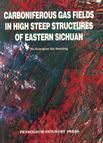中国四川东部高陡构造石炭系气田
出版时间:1997-6 出版社:石油工业出版社 作者:胡光灿,谢姚祥 编 页数:156
内容概要
This book is a memoir summarizing the exploration experiences of the pasttwenty years in gas field of high steep structures of eastern Sichuan. The analysison five fold-deformation styles of high steep structures gives the vertical variationmodel of the high steep structures.Petroleum generation model,petroleumpotential. reservoir characteri stics. migration and accumulation course,preservation of Carboniferous natural gaspools and pool forming model are systemmatically discussed in this book. Enrichment regularities are put forward Description on case histories are included.Tr0Ublesome questions and how to solvethem are discussed. This book is useful for researchers and explorationists worked in compl icatenatural gas domain. It,is also helpful to teachers and students of university and college.
书籍目录
1.INTRODUCTION L1.1 Discovery and exploration of Carboniferous gas pool1.1.1 Before the discovery1.1.2 Discovery of Carboniferous pool1.1.3 Exploration on Carboniferous pool1.2 Works done and results Of exploration1.2.1 Seismic1.2.2 Drilling2.FOLDING AND DEFORMATION CHARACTERS OF HIGH STEEP STRUCTURES INEASTERN SICHUAN AND THEIR VERTICAL.VARIATION GEOLOGICAL MODEL2.1 Basement structure and history of depositional cover2.1.1 Orerview on basement structure2.1.2 Sedimentary cover2.1.3 Regional structure2.2 Folding and deformation in Chuandong high steep structures2.2.1 2nd weak rock group(Leikoupu formation to Jia II member of Jialingjiang fomlation)--topthin-limb thick disharmonic fold model2.2.2 1st weak rock group(Silurian)--top thick-limb thin fold model2.2.3 Shallow level(Jurassic to upper Triassic)--high steep fold model2.2.4 Middle level(Carboniferous to Permian)disintegrated fold model2.2.5 Deep 1evel(Ordovidan to Cambrian)--Y shape horst model2.3 Vertical variation geological model and its forming mechanism2.3.1 Vertical variation geological model2.3.2 Forming mechanism3.FORMING CONDITIONS OF CARBONIFEROUS GAS POOL3.1 Petroleum source and potential 3.1.1 Genetic type of natural gas3.1.2 Petroleum source rock3.1.3 Petroleum forming model and petroleum potential3.2 Reservoir character and evolution of pore3.2.1 Division of strata and lithologic changes3.2.2 Paleogeography3.2.3 Deposition model3.2.4 Pore structure and reservoir type3.2.5 Diagesis and evolution of pore3.2.6 Factors control the forming of reservoir and reservoir assessment3.3 Migration and accumulation of petroleum 3.3.1 First migration of petroleum3.3.2 Secondary migration3.3.3 Trap types and hydrocarbon accumulation3.4 Preservation conditions of natural gas3.4.1 Mechanism of direct seal3.4.2 Mechanism of indirect seal3.4.3 Vertical hydrogeological Zonation4.POOL FORMING MODEL OF CARBONIEEROUS GAS AND ACCUMULATIONREGULARITIES4.1 Forming history of Carboniferous gas pool4.1.1 Application of basin numeric modeling4.1.2 Forming history of Carboniferous pool 4.2 Pool forming model of Carboniferous gas4.2.1 Early accumulation model(two forming stages model)4.2.2 Late accumulation model(one forming stage model)4.3 Enrichment regularities of Carboniferous gas pool4.3.1 High petroleum potential strength area4.3.2 Effective reservoir in favorable facial zone4.3.3 Inherited large paleouplift 4.3.4Goodd trap4.3.5 Low potential area of present fluid potential field·4.4 Case history of Carboniferous gas pools4.4.1 Wubaiti Carboniferous gas pool of Datianehi structural belt4.4.2 Longtou-Diaozhongba gas pool_-Dachiganjing structural belt5.EXPLORATION TECHNIQUES OF HIGH STEEP STRUCTURE GAS Pool 5.1 Processing.sequential and model interpretation of seismic data in high steep structures5.1.1 Establishment of vertical variation model for high steep structure5.1.2 Establishment of physical model of high steep structure5.1.3 Migration methods and techniques of processing for high steep structure5.1.4 Fine interpretation of seismic sections in high steep structure5.2 Lateral prediction of Carboniferous reservoir5.2.1 Prediction of Carboniferous thicknes5.2.2 Prediction on rank of reservoir quality 5.3 Prediction of gas water contact-pseudo pressure coefficient method5.3.1 Prediction of gas water contact by pseudo pressure coefficient5.3.2 Defining the pseudo pressure coefficient5.3.3 Case histories5.4 Selection of targets and targeting by directional side well5.4.1 Selection of target5.4.2 Directional side well6.GENERAL REMARKS AND FORECAST6.1 General remarks 6.2 Forecast……REFERENCES PLATE AND EXPLANATORY NOTES
图书封面
评论、评分、阅读与下载
用户评论 (总计0条)
相关图书
- 中国石油地质志
- 职业技能培训教程与鉴定试题集(下)
- 职业技能培训教程与鉴定试题集(题集上册)
- 职业技能培训教程与鉴定试题集(题集下册)
- 职业技能培训教程与鉴定试题集(题集上册)
- 元氣少女緣結神 vol.6
- 元氣少女緣結神 vol.7
- 三维VSP地震勘探技术
- 塔里木盆地沉积层序特征及其演化
- 牙轮钻头工作力学
- 2013最新版·西藏自治区公务员录用考试专用教材
- 2013最新版·西藏自治区公务员录用考试专用教材
- 我最喜爱的电子琴流行与经典
- 我最棒男孩经典故事大全
- 膜科学与技术基础
- 跨文化交际专题研究
- 少儿钢琴趣味教程
- 黎曼几何
- 离散几何讲义
- 劳动法与社会保障法
- 雷锋精神学习读本
- 实用版法规专辑
- 微分几何
- 人生最大的失败就是光说不练
- 企业战略管理
